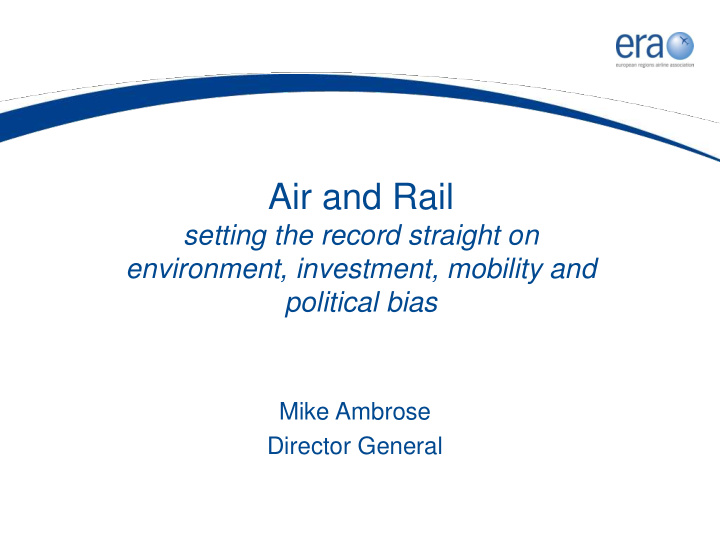



Click on here for Title Air and Rail setting the record straight on environment, investment, mobility and political bias Mike Ambrose Director General
Click on here for Title WHY A NEW STUDY? EC and State policies together with financial subsidies are heavily balanced in favour of rail, especially High Speed Rail (HSR) EC advocates modal substitution claiming HSR’s green credentials, social and economic benefits and returns on investments The preferences for rail are not supported by objective published analyses, assessments and other evidence The ERA study attempts to provide the objectivity needed to ensure a better balance between air and rail
Click on here for Title KEY FINDINGS OF THE STUDY TOPICS COVERED The existing air and rail networks in Europe The environmental consequences of air and rail transport What makes the better economic sense, investment in air or rail? Is the consumer better served by modal complementarity, competition or substitution? The regulatory and political approach to air and rail transport
Click on here for Title KEY FINDINGS OF THE STUDY
Click on here for Title Enterprises and turnover The number of aviation-related enterprises is 5.6 times higher than the number of rail enterprises in Europe The turnover of EU- 27 air transport market is almost twice that of railways
Click on here for Title Modal substitution The EC’s policy of mode substitution from air to rail has proved unsuccessful
Click on here for Title State subsidies The EU-27 yearly State subsidies for rail are 125 times higher than State aid granted to air transport
Click on here for Title Connectivity and networks EU airports and airlines offer 150,000 city pairs versus 100 from HSR Air transport is the true Trans- European Network
Click on here for Title Connectivity and networks Expanding the HSR network to link all major city-pairs currently connected by at least 10 flights a day would: require a 600% increase in the HSR network result in less than 5% reduction of flights demand by 2030 [EUROCONTROL]
Click on here for Title Environmental consequences KEY FINDINGS OF THE STUDY Environmental consequences fair comparison of CO 2 emissions between air and rail is not possible due to the different sources of power rail’s nuclear footprint has a massive impact for example, the estimated cost of UK nuclear decommissioning and waste disposal of the 19 existing nuclear plants is € 100bn over 50 years recent events have called into question the safety of nuclear power no energy source has a ‘zero’ impact on society
Click on here for Title Environmental consequences KEY FINDINGS OF THE STUDY Environmental consequences Traditional comparisons of the environmental impact of comparable emissions ‘at the point of use’ distort the results The ‘greenness’ of HSR is unfounded when assessed from a full ‘life cycle’ perspective Independent data show that for various HSR routes emissions from rail are higher than an equivalent air route [CO/150%, NOx/50%, VOC/500%, PM10/150%]
Click on here for Title Investment sense KEY FINDINGS OF THE STUDY Environmental consequences Investment sense The average investment cost of a new runway builds just 30 km of HSR track [Frankfurt’s new € 4bn runway and terminal will deliver a +50% capacity and 97,000 additional jobs] By contrast the planned Turin-Lyon HSR link forecasts losses of € 19bn over the life of the project; similar losses expected for the London- Midlands HSR project Renewed investment in regional airports and SESAR would reduce un- accommodated demand by up to 40%
Click on here for Title Investment sense Rail investments have often resulted in huge losses for taxpayers
Click on here for Title Consumer benefits KEY FINDINGS OF THE STUDY Environmental consequences Investment sense Consumer benefits Rail versus Air - is the consumer better served by complementarity, competition or substitution? Rail and air can complement each other [and offer more choice and convenience to consumers] provided complementarity is based on fair competition and freedom of consumer choice
Click on here for Title Inter-modality KEY FINDINGS OF THE STUDY Environmental consequences Investment sense Inter-modality Increasing the attractiveness of intermodality requires considerable and expensive improvements in: price and journey time schedule coordination seamless security checks compatibility of IT infrastructure and booking systems air/rail coordination in case of missed connections passenger rights
Click on here for Title Regulatory aspects KEY FINDINGS OF THE STUDY Environmental consequences Investment sense Inter-modality Regulatory aspects Unjustified differentiation exists in Air/Rail passenger rights: exemptions are granted to rail operators but not air compensation is not due to rail passengers for circumstances not connected with the operation of railway amount of compensation air: € 125 - € 600 train: 25% - 50% of ticket price Unbalanced security standards and funding of security costs
Click on here for Title Trans-European Networks Out of 30 TEN-T EU priority projects: 19 to rail ( € 318.7bn) 1 to air ( € 1.34bn)
Click on here for Title Conclusions KEY FINDINGS OF THE STUDY Environmental consequences Investment sense Inter-modality Conclusions The study uses information and source data from open and published sources ‘Green credentials’ of HSR are often unjustified and unclear HSR will not deliver cost- effective mobility Complementarity rather than substitution would better serve users’ interests Future investments should be supported by more objective business cases
Click on here for Title Conclusions KEY FINDINGS OF THE STUDY Environmental consequences Investment sense Inter-modality Conclusions A level playing field should be based on fair competition and equal treatment between competing modes Preferential treatment granted to a single transport mode based on poor or inexistent evidence can no longer be justified
Recommend
More recommend